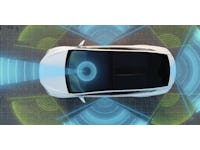Unlocking Tomorrow's Vision: Exploring Lidar Technology Trends in 2024
Apr 08, 2024
Dr Xiaoxi He

As autonomous driving continues to revolutionize the automotive industry, sensor technologies have undergone unprecedented advancements. One innovation standing out is Light Detection and Ranging (Lidar). Utilizing laser light to measure distances and create precise 3D maps of surroundings, Lidar has emerged as a game-changer in perception capabilities, especially for the automotive industry.
With roots tracing back to the invention of lasers in the 1960s, Lidar's journey gained momentum in the 2000s with the development of 3D Lidar systems. These systems, equipped with advanced beam steering mechanisms, offer unparalleled advantages over traditional sensing technologies such as cameras, radar, and ultrasonic systems. By providing high-resolution 3D point clouds and accurate range detection, Lidar enhances safety and perception capabilities.
Stepping into 2024, Lidar adoption has reached new heights, with widespread recognition across various industries. While its initial integration into the automotive sector aimed to address the limitations of existing sensors, recent research suggests a shift in adoption trends. According to IDTechEx's new report, "Lidar 2024-2034: Technologies, Players, Markets & Forecasts", performance considerations no longer solely drive the adoption of Lidar in automotive applications.
Tier 1 and Tier 2 companies approach Lidar adoption differently. Tier 2 companies focus on technology advancement and performance improvement, while Tier 1 companies prioritize factors with more considerations for commercialization and scalability.
Although Lidar's initial appeal lies in its unique value propositions compared to existing sensors, the current and near-future adoption in the automotive industry tends to be driven by factors beyond performance. OEMs are opting for Lidar systems that align with market demands and technological advancements, balancing benefits like trend alignment, positive promotion, and hardware readiness for future updates. One example is the adoption of beam steering technology. The development and innovation of beam steering technology in lidar systems has been one of the major focuses of various start-ups and major players, with four main technologies dominating the field: Mechanical, MEMS, Optical phased array (OPA), and Flash. Initially, 360° mechanical rotating lidars were prominent, especially in the development of Robotaxi. However, their high cost and reliability issues limited their use in the automotive industry. Semi-solid or hybrid mechanical beam steering technologies, such as rotating mirrors, MEMS, and prisms, are gaining traction, with some products meeting automotive grade standards. Among these, rotating mirrors are favored by Tier 1 and OEMs for their reliability and cost-effectiveness. MEMS, although facing challenges like irregular point clouds and reliability concerns, is still selected by some. Flash lidar is popular for short detection ranges, while OPA is seen as a promising future direction. However, practical adoption prioritizes readiness over potential in the current landscape at the moment and also in near future adoption.
Amidst this landscape, Lidar performance remains crucial, but other factors like cost-effectiveness, reliability, supply chain efficiency, and ease of integration take center stage. These factors not only influence technology choices but also pave the way for a future where Lidar continues to evolve and shape industries beyond automotive.
To gain deeper insights into the evolving landscape of Lidar technology and its impact on markets, see the new IDTechEx report on the topic, "Lidar 2024-2034: Technologies, Players, Markets & Forecasts". This report navigates the future of autonomous technologies, unlocking new possibilities and reshaping industries.
IDTechEx has focused on players who position themselves as automotive Tier 2 suppliers, covering component suppliers and automotive OEMs. The market forecasts provided are based on the extensive analysis of primary and secondary data, combined with careful consideration of market drivers, restraints, and key player activities. The technology adoption roadmaps for six types of lidar in four types of level 3+ autonomous vehicles are evaluated to provide a balanced outlook on market opportunities. The report finds that lidar for the automotive market is expected to grow to US$9.5 billion by 2034.
The report answers important questions such as:
- What lidar technology choices are available today, and how do these choices impact product development and positioning?
- What is the present status of each lidar technology, and what are the future trends and opportunities?
- How is the lidar business landscape evolving in terms of the supply chain, efforts, and partnerships?
- How will each lidar market segment evolve in the short-term and long-term?
For more information on technology benchmarking, business opportunity exploration, player activity tracking, and market analysis, please refer to the IDTechEx report "Lidar 2024-2034: Technologies, Players, Markets & Forecasts".
To find out more about this IDTechEx report, including downloadable sample pages, please visit www.IDTechEx.com/Lidar.
For the full portfolio of market research from IDTechEx, please see www.IDTechEx.com.
Upcoming free-to-attend webinar
Insights into Future Lidars for Automotive Applications
Dr Xiaoxi He, Research Director at IDTechEx and author of this article, will be presenting a free-to-attend webinar on the topic on Thursday 18 April 2024 - Insights into Future Lidars for Automotive Applications.
This webinar will start from the core working principles and components to analyze the current status and future trends of lidar development as well as adoption.
Key points covered will include:
- LiDAR's significance in vehicle autonomy
- Introduction to LiDAR working principles
- Examination of lidar technology choices and combinations
- Shifts in LiDAR technology trend
- Factors influencing current LiDAR adoption
Please click here to check timings and register for your specific time zone.
If you are unable to make the date, please register anyway to receive the links to the on-demand recording (available for a limited time) and webinar slides as soon as they are available.